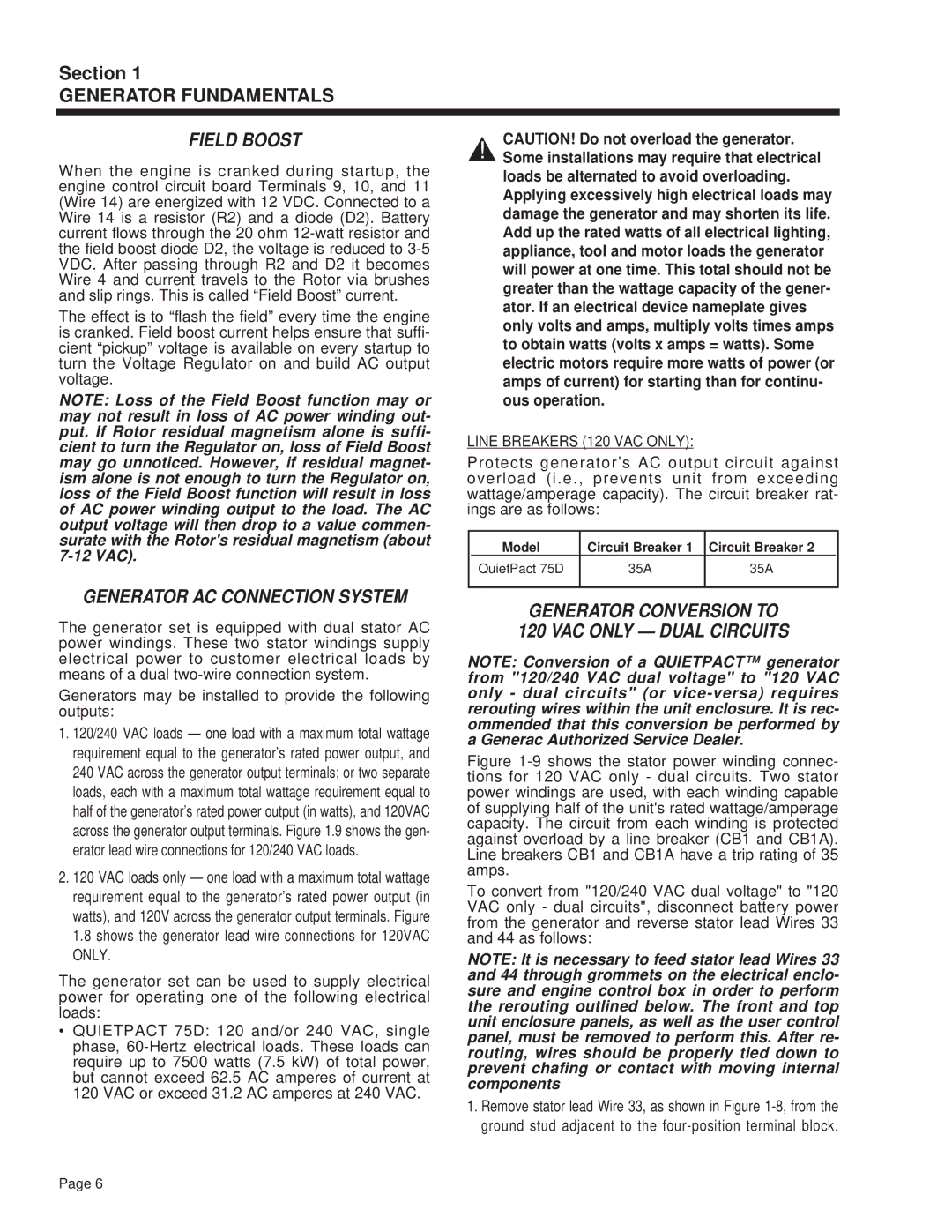Section 1
GENERATOR FUNDAMENTALS
FIELD BOOST
When the engine is cranked during startup, the engine control circuit board Terminals 9, 10, and 11 (Wire 14) are energized with 12 VDC. Connected to a Wire 14 is a resistor (R2) and a diode (D2). Battery current flows through the 20 ohm
The effect is to “flash the field” every time the engine is cranked. Field boost current helps ensure that suffi- cient “pickup” voltage is available on every startup to turn the Voltage Regulator on and build AC output voltage.
NOTE: Loss of the Field Boost function may or may not result in loss of AC power winding out- put. If Rotor residual magnetism alone is suffi- cient to turn the Regulator on, loss of Field Boost may go unnoticed. However, if residual magnet- ism alone is not enough to turn the Regulator on, loss of the Field Boost function will result in loss of AC power winding output to the load. The AC output voltage will then drop to a value commen- surate with the Rotor's residual magnetism (about
CAUTION! Do not overload the generator. Some installations may require that electrical loads be alternated to avoid overloading. Applying excessively high electrical loads may damage the generator and may shorten its life. Add up the rated watts of all electrical lighting, appliance, tool and motor loads the generator will power at one time. This total should not be greater than the wattage capacity of the gener- ator. If an electrical device nameplate gives only volts and amps, multiply volts times amps to obtain watts (volts x amps = watts). Some electric motors require more watts of power (or amps of current) for starting than for continu- ous operation.
LINE BREAKERS (120 VAC ONLY):
Protects generator’s AC output circuit against overload (i.e., prevents unit from exceeding wattage/amperage capacity). The circuit breaker rat- ings are as follows:
| Model | Circuit Breaker 1 | Circuit Breaker 2 |
|
| QuietPact 75D | 35A | 35A |
|
|
|
|
|
|
GENERATOR AC CONNECTION SYSTEM
The generator set is equipped with dual stator AC power windings. These two stator windings supply electrical power to customer electrical loads by means of a dual
Generators may be installed to provide the following outputs:
1.120/240 VAC loads — one load with a maximum total wattage requirement equal to the generator’s rated power output, and 240 VAC across the generator output terminals; or two separate loads, each with a maximum total wattage requirement equal to half of the generator’s rated power output (in watts), and 120VAC across the generator output terminals. Figure 1.9 shows the gen- erator lead wire connections for 120/240 VAC loads.
2.120 VAC loads only — one load with a maximum total wattage requirement equal to the generator’s rated power output (in watts), and 120V across the generator output terminals. Figure 1.8 shows the generator lead wire connections for 120VAC ONLY.
The generator set can be used to supply electrical power for operating one of the following electrical loads:
•QUIETPACT 75D: 120 and/or 240 VAC, single phase,
GENERATOR CONVERSION TO 120 VAC ONLY — DUAL CIRCUITS
NOTE: Conversion of a QUIETPACT™ generator from "120/240 VAC dual voltage" to "120 VAC only - dual circuits" (or
Figure 1-9 shows the stator power winding connec- tions for 120 VAC only - dual circuits. Two stator power windings are used, with each winding capable of supplying half of the unit's rated wattage/amperage capacity. The circuit from each winding is protected against overload by a line breaker (CB1 and CB1A). Line breakers CB1 and CB1A have a trip rating of 35 amps.
To convert from "120/240 VAC dual voltage" to "120 VAC only - dual circuits", disconnect battery power from the generator and reverse stator lead Wires 33 and 44 as follows:
NOTE: It is necessary to feed stator lead Wires 33 and 44 through grommets on the electrical enclo- sure and engine control box in order to perform the rerouting outlined below. The front and top unit enclosure panels, as well as the user control panel, must be removed to perform this. After re- routing, wires should be properly tied down to prevent chafing or contact with moving internal components
1.Remove stator lead Wire 33, as shown in Figure
Page 6
